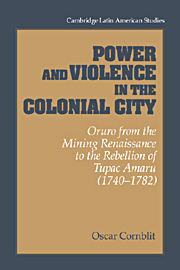 Power and Violence in the Colonial City
Power and Violence in the Colonial City Book contents
- Frontmatter
- Contents
- List of figure, maps, and tables
- Preface
- Map 1 Present-day Bolivia and surrounds
- Map 2 Principal routes of the Viceroyalty of Peru (second half of the eighteenth century)
- 1 Oruro between two epochs: a mining cycle
- 2 Under Spanish law
- 3 Oruro in 1741: details of a stormy election
- 4 The people
- 5 “Madmen, comedians, and hypocrites”
- 6 Captains of shipwreck
- 7 Returning to the known
- 8 “The fruits of the earth”
- 9 The end of an epoch: the Indian uprisings of 1780–1781
- 10 Oruro in the economic and geopolitical context of the epoch (c. 1780–1781)
- 11 The Oruro uprising
- 12 The voice of the rebels
- 13 Picking up the pieces
- Appendix A Indian raids on Oruro, 1781: testimonies
- Appendix B Testimonies of inhabitants of the city
- Appendix C Table of public jobs in Oruro, 1730–1784
- Bibliography
- Index
- CAMBRIDGE LATIN AMERICAN STUDIES
2 - Under Spanish law
Published online by Cambridge University Press: 30 March 2010
- Frontmatter
- Contents
- List of figure, maps, and tables
- Preface
- Map 1 Present-day Bolivia and surrounds
- Map 2 Principal routes of the Viceroyalty of Peru (second half of the eighteenth century)
- 1 Oruro between two epochs: a mining cycle
- 2 Under Spanish law
- 3 Oruro in 1741: details of a stormy election
- 4 The people
- 5 “Madmen, comedians, and hypocrites”
- 6 Captains of shipwreck
- 7 Returning to the known
- 8 “The fruits of the earth”
- 9 The end of an epoch: the Indian uprisings of 1780–1781
- 10 Oruro in the economic and geopolitical context of the epoch (c. 1780–1781)
- 11 The Oruro uprising
- 12 The voice of the rebels
- 13 Picking up the pieces
- Appendix A Indian raids on Oruro, 1781: testimonies
- Appendix B Testimonies of inhabitants of the city
- Appendix C Table of public jobs in Oruro, 1730–1784
- Bibliography
- Index
- CAMBRIDGE LATIN AMERICAN STUDIES
Summary
Before we become enmeshed in the details of the history of Oruro in the second half of the eighteenth century, it is a good idea to review the normative and institutional framework of the age. It is also useful to compare the general functioning of Spanish colonial structure – using the most representative works on the theme – with the specific case of a Spanish American city that, like many others, reveals a past rich in historical detail that at times corroborates accepted opinion but in some cases presents contrasts and exceptions worthy of reflection.
According to Clarence Haring, the two primary characteristics of the Spanish imperial government in America were the division of authority – with the consequent allocation of responsibility in the functions of government – and the profound jealousy of the crown with respect to the initiatives of colonial officials. Thus, the government was not founded, as modern states are, on the division of the legislative, executive, and judicial powers, but rather divided authority among individuals or institutions who generally shared the same powers. The problem lay in the imprecise delineation of functions. This situation, with its great number of superimposed jurisdictions was, one assumes, created directly by the crown.
In any case, the policy had its risks. The lack of direct control from Spain, a result of its great distance, bestowed a high degree of independence on the colonial powers, who were often ignorant not only of many royal mandates but also of general laws and regulations.
At the head of local administration was the viceroy or captain general, assigned to his particular geographical zone.
- Type
- Chapter
- Information
- Power and Violence in the Colonial CityOruro from the Mining Renaissance to the Rebellion of Tupac Amaru (1740–1782), pp. 11 - 36Publisher: Cambridge University PressPrint publication year: 1995


